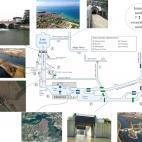PhD student: Luigi Hinegk. Supervisors: Marco Tubino, Guido Zolezzi and Luca Adami
Ph.D. degree on 07/10/2022
“When the well is dry, we know the worth of water” (Benjamin Franklin, Poor Richard's Almanac, 1746). This quote may summarize the widespread unefficient use of water and the overall context of drought in which we are living today. Indeed, water stands out as a major natural resource that is more and more required but less and less available for sustaining not only human activites but also ecosystem livelihood. Although the installation of several hydraulic infrastructures (e.g. dams) have permitted a better management of many lakes and rivers, new and ever-increasing needs are now posing novel challanges for the efficient use and balanced allocation of the available water resources. Precisely, hydraulic infrastructures have greatly improved flood control, water provision and other related services (e.g. navigation, fishery,…) since the second half of the last century. However, the non-sustainable design of these infrastructures today fails to guarantee the safeguard of the water ecosystem, and water managers recognize that the satisfaction of the human water-related benefits rely on the proper maintenance of the livelihood and services of its provider, i.e. the water ecosystem.
This framework raises our research questions: is there a way to ensure water for all the multiple and interdependent human and ecosystem needs? How to pursue such goal with limited availability of water resources and the complex regulation of hydraulic infrastructures?
To address these questions, we are developing a water budget-optimization model with the aim of providing to river basins’ stakeholders alternative water management strategies that seek an efficient and balanced allocation of water resources also in view of their higher uncertainty in future availability.
On one hand, the computation of a water budget allows to assess the quantity of water that is actually available within a freshwater body given the evolving influence of environmental factors (e.g. climate change) as well as anthropic activities (e.g. irrigation and hydropower requirements). On the other hand, the optimization model represents a novel approach to find the best allocation strategy of the available water resources and therefore pursue a “win-win” solution amongst the contrasting water requirements.
Moreover, to provide useful strategies that can be applied to real-world contexts, we are investigating the highly regulated Garda-Mincio basin (northern Italy) as a baseline case study.
Precisely, in such nationally relevant system, the Mincio River connects the biggest lake of Italy (Lake Garda) with the longest river of the country (Po River) through a series of hydraulic infrastructures (dams, weirs, locks,…) which management needs today to be upgraded to cope with the multiple emerging water demands within the basin.
The model development is carried out along with field work campaigns to record bathymetric and water discharge data as well as with meetings to exchange information with the basin stakeholders, amongst which the Interregional Agency for the Po River (AIPo) represents the main partner.

